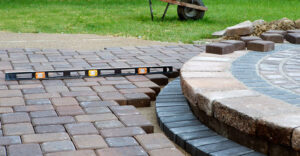Understanding the Challenge of Cold-Climate Landscaping
Designing a garden in Massachusetts or anywhere in New England requires balancing beauty, resilience, and practicality. With long winters, unpredictable frosts, and short growing seasons, cold climates demand strategic planning.
From choosing hardy plants to ensuring proper drainage, your garden design should be built to thrive year-round — not just in summer. Let’s explore how to plan a stunning and sustainable garden that survives and shines through the New England chill.
Step 1: Start with Smart Garden Planning
Before you plant a single seed, ask yourself these essential questions:
✅ How does sunlight hit your yard throughout the day?
✅ Which areas retain moisture or freeze easily?
✅ What’s your soil type — clay, loam, or sandy?
✅ Where does snow accumulate or melt first?
Mapping out your property’s microclimates helps you understand where each plant will thrive.
Pro Tip:
Hire a local Massachusetts landscape designer to conduct a site analysis. They’ll evaluate slope, drainage, and exposure — key details that can make or break your garden in cold weather.
Step 2: Choose Cold-Hardy Plants and Shrubs
In the New England region, not every plant can withstand freezing winters. Look for varieties that are USDA Hardiness Zone 3–6 rated — ideal for most Massachusetts locations.
Here’s a handy list of cold-tolerant favorites:
| Category | Recommended Plants |
|---|---|
| Evergreens | Boxwood, Yew, Juniper, Spruce |
| Perennials | Hostas, Daylilies, Black-Eyed Susans |
| Shrubs | Hydrangeas, Viburnum, Lilac |
| Groundcovers | Creeping Thyme, Pachysandra, Ajuga |
| Trees | Red Maple, Dogwood, Birch, White Pine |
Pro Tip: Mix evergreens with deciduous shrubs to maintain visual interest all year long — even when the snow falls.
Step 3: Design for Winter Interest
A beautiful garden shouldn’t disappear under snow. Instead, plan for all four seasons.
Here’s how to make your Massachusetts garden attractive even in mid-January:
✅ Incorporate texture: Ornamental grasses and seed heads add visual movement.
✅ Add structure: Stone walls, raised beds, and pathways look stunning against snow.
✅ Plant color strategically: Red twig dogwood or winterberry shrubs provide bright contrast.
✅ Use evergreens as anchors: They give form and color when everything else is dormant.
Example:
Pairing tall pines with snow-dusted hydrangea stems can create a naturally elegant winter scene.
Step 4: Protect Your Soil and Roots from the Col
Cold New England winters can be harsh on soil and roots.
Follow this checklist to safeguard your landscape:
✅ Mulch generously — a 2–3 inch layer protects roots from frost.
✅ Avoid compacting soil — don’t walk on frozen garden beds.
✅ Install windbreaks — fences or hedges prevent snow drift damage.
✅ Water before freeze-up — hydrated plants handle cold stress better.
Pro Tip:
Organic mulch such as shredded bark or compost not only insulates but also improves soil structure over time.
Step 5: Plan Drainage and Snow Management
New England winters bring melting snow, which can flood gardens if drainage isn’t planned properly.
A professional landscaper can help with:
- Grading and sloping your property correctly
- Installing French drains or dry wells
- Choosing permeable pavers for walkways and patios
- Designing snow storage zones where meltwater won’t harm plants
Proper drainage ensures your garden doesn’t turn into a swamp every spring.
Step 6: Use Durable Materials for Hardscaping
Massachusetts’ freeze-thaw cycles can damage patios and walkways if built with weak materials.
Here’s a quick comparison:
| Material | Cold-Weather Performance | Maintenance |
|---|---|---|
| Concrete | Can crack if not sealed properly | Moderate |
| Natural Stone | Excellent — ideal for patios | Low |
| Brick Pavers | Durable and stylish | Low to moderate |
| Wood Decking | Needs treatment to resist frost | High |
Recommendation:
Go with granite, bluestone, or concrete pavers — they withstand harsh winters and still look elegant in summer.
Step 7: Create a Year-Round Maintenance Plan
Cold-climate landscaping requires consistent care.
A solid plan includes:
✅ Fall cleanup: Remove debris to prevent mold and pests.
✅ Winter pruning: Shape trees and shrubs during dormancy.
✅ Spring inspection: Check for frost damage and reapply mulch.
✅ Summer fertilizing: Boost plant growth during active months.
DIY vs. Professional Design: Which Is Better for You?
| Aspect | DIY Landscaping | Professional Design |
|---|---|---|
| Planning Expertise | Limited by personal research | Comprehensive site and climate analysis |
| Plant Selection | Trial and error | Tailored to soil and microclimate |
| Cost | Lower upfront | Higher initial, but better long-term value |
| Results | Inconsistent | Cohesive and lasting design |
Verdict:
If you want a garden that thrives through Massachusetts winters, hiring professionals ensures a design that’s both beautiful and durable.
Why Choose Green Leaves Landscape
At Green Leaves Landscape, we specialize in cold-climate landscape design across Massachusetts and the broader New England region.
Our team understands how to balance aesthetics with function — from plant selection to drainage design — ensuring your garden stays healthy through every season.
💬 Ready to transform your backyard?
Contact us today at greenleaveslandscape.com/contact to schedule a free design consultation.
FAQs About Cold-Climate Garden Design
Q1: What’s the best time to start planning a New England garden?
Late winter or early spring is ideal. It allows time to design and prepare the soil before planting season.
Q2: Can tropical plants survive in Massachusetts?
Generally no — but you can use containers for tender plants and bring them indoors during winter.
Q3: How do I prevent frost damage to new plants?
Mulch heavily, water before frost, and use burlap wraps or frost cloth for protection.
Q4: Do I need irrigation if it rains often?
Yes — consistent watering is essential in dry winter or early spring months when rainfall may be limited.
Q5: How much does professional garden design cost in Massachusetts?
Design packages range from $1,500–$5,000, depending on the size and complexity of your project.
Q6: Can Green Leaves Landscape handle installation too?
Absolutely! We offer full-service landscape design, excavation, and installation, making it easy for homeowners to enjoy a hassle-free experience.
Final Thoughts & Call to Action
Designing a garden that thrives in New England’s cold climate takes planning, creativity, and expert guidance.
From hardy plant choices to smart drainage and durable materials, every detail contributes to a landscape that’s both functional and beautiful — no matter the season.
🍃 If you’re ready to start designing your dream garden, contact Green Leaves Landscape today.
Let’s build a backyard that blooms beautifully — even when the snow falls.






